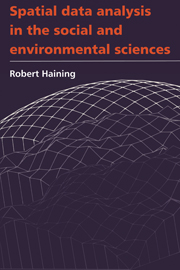Book contents
- Frontmatter
- Contents
- List of tables and displays
- Preface
- Acknowledgements
- PART A Introduction to issues in the analysis of spatially referenced data
- PART B Parametric models for spatial variation
- 3 Statistical models for spatial populations
- 4 Statistical analysis of spatial populations
- PART C Spatial data collection and preliminary analysis
- PART D Modelling spatial data
- Postscript
- Glossary
- References
- Index
3 - Statistical models for spatial populations
Published online by Cambridge University Press: 05 August 2012
- Frontmatter
- Contents
- List of tables and displays
- Preface
- Acknowledgements
- PART A Introduction to issues in the analysis of spatially referenced data
- PART B Parametric models for spatial variation
- 3 Statistical models for spatial populations
- 4 Statistical analysis of spatial populations
- PART C Spatial data collection and preliminary analysis
- PART D Modelling spatial data
- Postscript
- Glossary
- References
- Index
Summary
This chapter introduces parametric statistical models for describing spatial variation. The approach followed is rather different from the presentation usually given of models for describing temporal variation. First, time is one-dimensional and the flow of time from past to present to future is usually assumed to impose a natural ordering or direction on patterns of interaction. Space on the other hand is two-dimensional and usually possesses no such equivalent ordering so that spatial models must allow for a wider range and more complex structures of interaction. Second, time series models such as autoregressive models can be specified in terms of covariances or joint probabilities or conditional probabilities. The three formulations are equivalent, and each gives rise to simple functional expressions. But spatial models with simple autoregressive representations in terms of variate relationships generally have covariance and correlation functions that are far from elementary; conditional and joint probability specifications of nearest neighbour spatial models are not equivalent and give rise to different orders of autoregressive model. Third, if the border value of a first order temporal autoregressive series is its initial value, the border or edge effects are of order 1/n where n is the length of the observed series. In the case of spatial data the boundary encircles the region. For an n = N×M rectangular lattice there are usually at least 2N+2M – 4 border sites, so specifying what happens at the edges is likely to be of more importance in the case of spatial models.
- Type
- Chapter
- Information
- Publisher: Cambridge University PressPrint publication year: 1990

